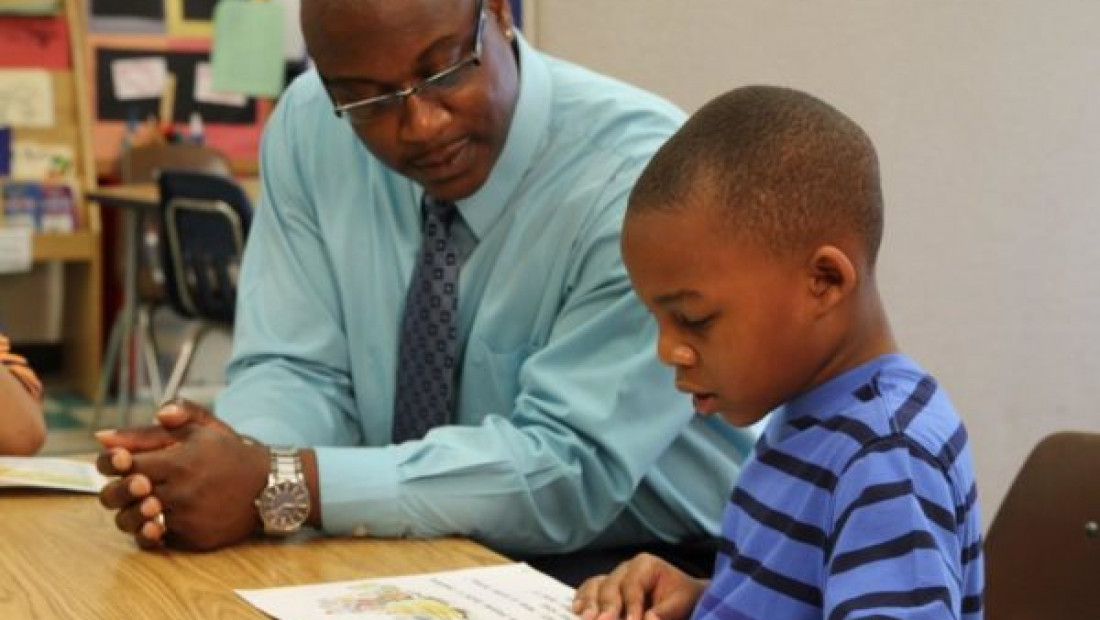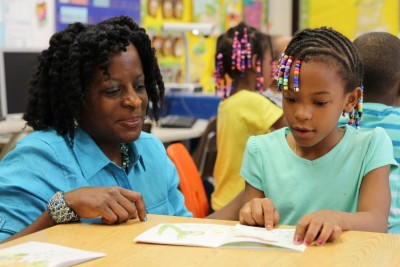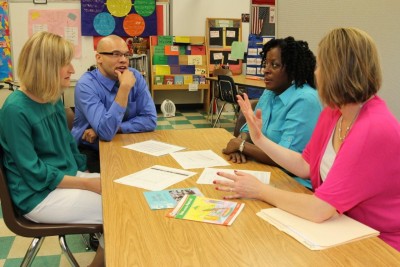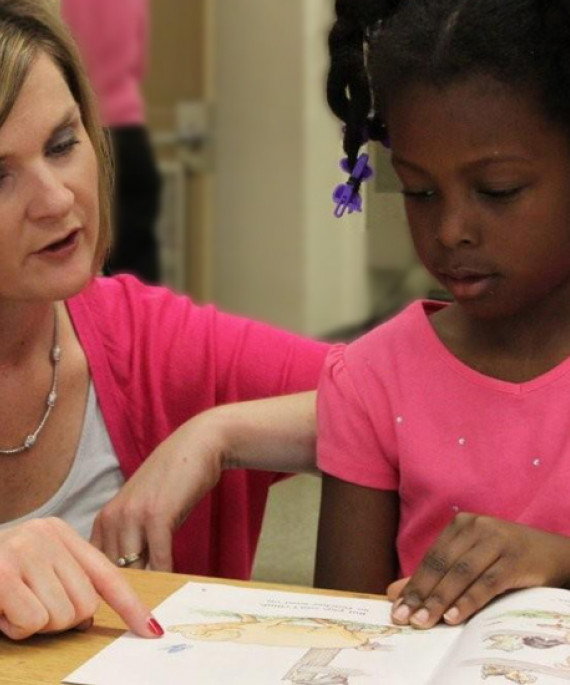
Nearly 400,000 school children improved their reading skills in a massive, five-year, national scale-up of Reading Recovery conducted by the College of Education and Human Ecology.
Reading Recovery is EHE’s short-term, one-to-one intervention that has helped 2.3 million struggling first-grade readers close the achievement gap since 1984. Introduced to the United States by Ohio State faculty, it is one of the oldest and most widely implemented literacy interventions in the world.
With $45.6 million in support from an Investing in Innovation (i3) grant under the U.S. Department of Education, as well as an addition $10.1 million from private donors, the scale-up added to this total and surpassed all its goals by achieving the following:
- 62,064 first-graders performing at the bottom of their classes in reading achievement received one-to-one Reading Recovery sessions.
- By the end of the 12- to 20-week intervention, the majority of children had closed the achievement gap and were reading on par with their classroom peers.
- 3,747* i3-trained teachers were certified in Reading Recovery by successfully completing two graduate courses (six semester hours) at an affiliated Reading Recovery University Training Center.
- The i3-trained Reading Recovery teachers taught children in 2,360 schools in 38 states.
- 335,586 additional children were instructed in small groups and classrooms by the Reading Recovery trained teachers during the rest of their school day.
- 49 teacher leaders were trained, instead of the originally planned 15. They provide ongoing professional coaching for the Reading Recovery teachers in their schools.
- Low-progress first-graders were learning to read 120 percent to 166 percent faster than typical learning rates for first-graders.**
- Significant positive effects on general reading achievement and reading comprehension. were substantial for English language learners and students in rural schools.
One key to scaling up best practices: An existing infrastructure
Jerry D’Agostino, professor and director of the i3 grant, pointed out the value to a scale-up of having a solid infrastructure. In this case, the infrastructure is the affiliated Reading Recovery university training centers.
In the 30 years since Ohio State brought Reading Recovery to the United States, the number of training centers has grown to 19. With leadership by Ohio State, they train teachers and teacher leaders, then maintain strong relationships with those teacher leaders who provide professional development to all the Reading Recovery teachers in their assigned school districts.
Most impressive was the fact that low-progress first-graders taught by the Reading Recovery teachers were learning to read 120 percent to 166 percent faster than typical rates of learning for first-graders.
Ongoing professional development is a hallmark of Reading Recovery. It provides collaborative opportunities for teachers to analyze the effectiveness of their instructional practices, get help about particularly hard-to-teach children and consider how new knowledge in the field may influence their practice.
These strong relationships also help preserve the fidelity of teacher training, as well as the consistency of teaching of Reading Recovery in schools across the country.
Success for rural schools and schools with many ELL students
Emily Rodgers, associate professor and co-director of the i3 grant, said the i3 scale-up had an especially positive impact on the literacy needs of children in low-performance rural schools, as well as on schools with large populations of English-language learner (ELL) students. These schools were made first priority for recruitment.
 Reading Recovery was proven to be three times more effective than similar reading programs by an independent study.
Reading Recovery was proven to be three times more effective than similar reading programs by an independent study.
The need for professional development in these schools is acute. Both often have a difficult time attracting and retaining highly qualified teachers or teachers with enough specialized training to serve students' literacy needs.
Yet these teachers are critical because their expertise is directly related to student achievement.
Across the five years of the i3 grant, the scale-up trained 546 teachers in 374 rural schools, representing about 15 percent of the total schools in the grant and reflecting the national average for rural schools.
The scale-up also trained 1,291 teachers in 836 schools with high numbers of ELL students. This represents about 35 percent of the schools in the grant, about three times the national average for ELL schools.
The impact of Reading Recovery on children’s learning at rural and ELL schools was equal to the learning in other schools. In fact, the impact tends to be larger in rural and ELL schools because participating students tend to have lower average scores on the Iowa Test of Basic Skills. They have more room for improvement.
Success at Morgan Local School District
In rural Ohio, Morgan Local School District credited Reading Recovery for the fact that its students are reading at levels outpacing the region. The Ohio Department of Education released K-3 literacy scores in May 2015. Morgan Local was one of only 27 districts in Ohio to earn an A. It also was the only district in 11 southeastern Ohio counties, an area of northern Appalachia, to earn a top mark.
The Zanesville Times Reporter told the story, explaining that “Those students in the bottom 20 percent receive an extra half hour of one-on-one instruction each day, working with certified instructors for 10 weeks.” Susan Troutner, assistant for instruction at Morgan Local, said, “It makes a tremendous difference for those kids.”
The lasting effects of innovative research on Reading Recovery
The i3 grant allowed D’Agostino and Rodgers to conduct innovative research on Reading Recovery. To reach more teachers with training, they created and tested a blended model – partly online, partly in person -- to make it accessible to those living the greatest distances from the nearest training center. Typically, these teachers work in rural areas.
The study found the blended model was just as successful as training that took place at a training center. This format, using technology to train teachers, will continue to be investigated by the national group of Reading Recovery trainers to test its efficacy. The benefits are lower costs and more teachers can take part in training.
D’Agostino and Rodgers also developed LetterWorks, an innovative iPad application for learning the alphabet. LetterWorks teaches students letter identification, a critical skill that is highly related to later reading achievement.
The researchers tested the use of LetterWorks in Reading Recovery. The app proved to help students at low-performing schools significantly outperform their peers who were taught with magnetic letters.
Despite this positive research finding, the study also collected data from the students’ teachers who expressed reluctance about continuing to use LetterWorks. They said their own theories of learning suggested that tactile learning is important for young children.
Implications from the study underscore the need for teacher education that addresses theories of learning. Simply telling teachers to take up a new practice without a strong rationale will likely not result in change.
These findings attracted much interest from participants at the 2015 American Educational Research Association conference when D’Agostino and Rodgers presented them at a poster session. Education Week also shared the results on April 20, 2015.
The Journal of Early Childhood Literacy has accepted an article about the results of this study by D’Agostino, Rodgers and two of their graduate students, Sinéad Harmey and Katherine Brownfield. Further interest is anticipated after its release, which is expected later this year.
Reading Recovery has exponentially expanded in the United States during the past 30 years, providing early literacy intervention to millions of young students and disseminating professional development to thousands of teachers who work with students who find learning to read difficult. Reading Recovery remains the highest rated beginning reading intervention by the government’s Institute of Education Sciences (IES) What Works Clearinghouse.
As of 2014-15, Reading Recovery was implemented in 42 of the United States as well as four other countries. Reconstructions of Reading Recovery have been developed for both the Spanish and French languages where bilingual instruction is available. In Spanish it is called Descubriendo la Lectura (DLL), and in French it is Intervention Préventive en Lecture-écriture (IPLE).
*Data are being finalized; more teachers may have been certified.
**The pace of reading improvement was documented by the independent external evaluator for the scale-up, the Consortium for Policy Research in Education (CPRE) at the University of Pennsylvania. CPRE used a random controlled trial design to study 6,888 children located at 41 schools.


